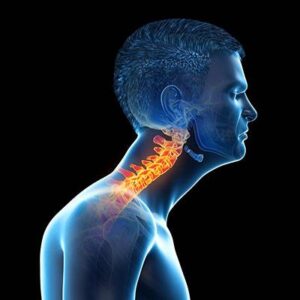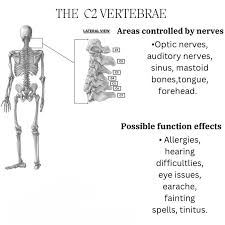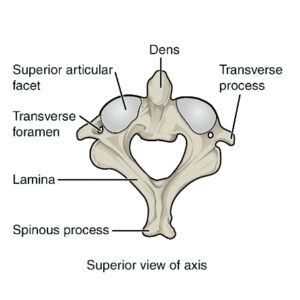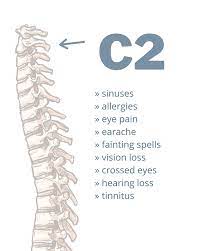

In order to learn how my bad neck posture adversely impacted my C2 vertebrae, all you need to do is spare 10 minutes of your precious time reading this article.
I have compiled this write-up using my personal experience.
I have been experiencing forward head posture for the past 7 years. I later learned that it took 3 years for my cervical spine to change its normal posture. Basically my c2 vertebrae was out of alignment.
The constant hunch of my shoulders while ogling my cellphone screen was to blame for my forward neck. Whatever the reason may be, I am not here to discuss how I developed nerd neck or vulture neck posture.
Instead, this article of mine reveals how and why my C1 vertebra was adversely affected by my forward neck.
So, let me begin without wasting your time any further:
Contents of “How My Bad Neck Posture Impact My C2 Vertebrae” Article:
1) How did I Get a Forward Neck?
2) What is My C2 Cervical Vertebrae?
3) What is the Function of My C2 Vertebrae?
4) How Did My Forward Head Posture Damage My C2 Vertebrae?
5) How did My Damaged C2 Vertebrae Adversely Affect My Life?
6) How did I Try and Treat My Damaged C1 Vertebrae?
7) FAQs on C2 Vertebrae & Poor Neck Posture
7) The Lesson I Learnt from My Forward Head Ordeal
How did I Get a Forward Neck?
It all started one fateful day when I decided to binge-watch an entire season of my favorite show.
My couch became my throne, my snacks were my royal feast, and my phone… oh, my loyal squire! Little did I know, this marathon session was about to change my life—well, my neck, to be precise.
You see, I was hunched over my phone, texting friends, scrolling through social media, and occasionally checking if the world outside my window still existed.
Hours turned into a full day, and by the time I got up, I felt like a question mark—literally. My neck was jutting forward, my shoulders slumped, and my back was protesting loudly.
“What on earth happened?” I wondered, staring at my reflection, which now resembled a tired turtle.
As it turns out, I had unwittingly fallen victim to the dreaded “forward neck” or “text neck,” a modern-day condition plaguing screen addicts like myself.
According to experts, spending extended periods with our heads tilted forward places immense strain on our necks. Imagine holding a bowling ball out in front of you for hours—yep, that’s what we’re doing to our necks!
When your head juts forward, it increases the load on your cervical spine by up to five times. That’s like asking your neck to carry a small backpack filled with bricks all day long! No wonder my neck was screaming for mercy.
Determined to fix this, I started incorporating some stretches and exercises into my daily routine, like chin tucks and shoulder blade squeezes. I also made a pact to hold my phone at eye level and take regular breaks from my screen.
Now, I’m slowly regaining my upright posture, and my neck is thanking me. So, if you ever find yourself resembling a question mark, remember: your neck is not a coat hanger. Treat it well, and it will hold your head high—literally!
What is My C2 Vertebrae?
Alright, let me introduce you to another superstar in your neck: the C2 vertebra, also known as the Axis. Think of it as the trusty sidekick to the C1 vertebra (the Atlas), working together to keep your head on straight—literally!
So, picture this: the C1 vertebrae is the hero holding up your skull, but it’s the C2 that gives you the superpower of rotation. Thanks to the Axis, you can shake your head “no,” look both ways before crossing the street, or give a dramatic side-eye when someone suggests putting ketchup on a steak.
The C2 vertebra is unique because it has a little tooth-like projection called the dens, or odontoid process. This dens fits perfectly into the ring of the C1 vertebra, allowing your head to swivel around with ease. It’s like a mini pivot joint, granting you the freedom to turn your head from side to side.
But the Axis isn’t just about head movement. It also plays a crucial role in protecting the spinal cord. The spinal cord runs through the vertebral foramen (a central hole in the C2), acting as a superhighway for nerve signals between your brain and the rest of your body.
Without the C2 vertebra doing its job, those nerve signals might get disrupted, causing all sorts of problems.
Now, imagine what would happen if the C2 vertebra got damaged. Not only would you lose some of your head-turning superpowers, but you could also experience pain, dizziness, and even difficulty in coordinating movements.
Thankfully, our bodies are pretty resilient, and with the right care, we can keep our C2 and the rest of our spine in good shape.
So next time you shake your head in disbelief or look around to spot your friend in a crowded room, give a little nod of appreciation to your C2 vertebra. It’s always there, working behind the scenes to keep you moving smoothly and looking fabulous.
What is the Function of My C2 Vertebrae?
Alright, folks, gather around because it’s time to meet the unsung hero of your neck—the C2 cervical vertebra, also known as the Axis. If your neck were a high-action movie, the C2 would be the cool gadget that makes everything possible.
Let’s dive into its fantastic functions!
First off, the C2 vertebra is your neck’s rotation maestro. Ever wondered how you can shake your head “no” or turn your head to admire that sunset? That’s all thanks to the Axis.
The C2 has a nifty little projection called the dens, or odontoid process. This peg-like structure fits snugly into the C1 vertebra (the Atlas) above it, forming a pivot joint. This joint allows your head to swivel around smoothly, giving you the freedom to look left and right.
But wait, there’s more! The C2 is also a key player in protecting your spinal cord. Think of the spinal cord as the main internet cable connecting your brain to your body’s Wi-Fi network.
The vertebral foramen, a hole in the C2, acts like a protective tunnel, ensuring that nerve signals travel without a hitch. If your C2 didn’t do its job, those signals could get scrambled, leading to all sorts of bodily confusion.
Now, let’s talk about teamwork. The C2 – vertebrae doesn’t work alone—it’s part of the dynamic duo with the C1. While the Atlas (C1) supports the skull, the Axis (C2) allows for rotation.
Together, they enable you to perform those dramatic head turns and subtle nods that are essential for daily life and epic dance moves.
Imagine if your C2 took a vacation. Turning your head would become a Herculean task, and your neck might feel like a rusty hinge.
Luckily, with proper care and posture, you can keep your C2 in top-notch condition, ensuring you remain the smooth operator you were born to be.
So, next time you glance over your shoulder or shake your head at a crazy idea, give a mental high-five to your C2 vertebra. It’s always there, making sure you can move with ease and style!
How Did My Forward Head Posture Damage My C2 Vertebrae?
Oh, where do I even begin?
My damaged C2 bone in neck turned my life upside down—and not in a fun, rollercoaster kind of way. It all started with a simple, innocent head shake. You know, the kind you do when you hear a crazy story. Little did I know, my C2 vertebra wasn’t having it.
>>> First off, my range of motion took a serious hit. Imagine trying to turn your head to check your blind spot while driving and feeling like you’ve hit an invisible wall. That was me, looking more like a robot than a human. Goodbye, smooth head turns. Hello, awkward body swivels.
>>> Then came the tension headaches. These weren’t your run-of-the-mill “I need a nap” headaches. These were epic migraines that felt like a tiny drummer was practicing for a rock concert inside my skull. Each beat echoed through my head, making it hard to focus on anything.
>>> The dizziness was the icing on this not-so-delicious cake. Picture walking through a funhouse, but without the fun. I’d stand up and the room would spin, leaving me feeling like I was on a perpetual merry-go-round.
>>> Despite the challenges, this experience taught me the importance of neck care. I started doing neck exercises such as chin tucks and shoulder stretches, improved my posture, and learned to appreciate the simple pleasure of a smooth head turn.
Tip for the Day: So, while my damaged C2 vertebra caused quite a ruckus, it also taught me to take better care of my neck and never take those effortless head movements for granted!
>>> Want to Learn How I Fixed My “Damaged C2 Vertebrae” at Home??? Click Here to Find Out! <<<
How did My Damaged C2 Vertebrae Adversely Affect My Life?
When your C2 vertebra goes rogue, life doesn’t just tilt—it spins, aches, and jolts with every move. What started as a mild neck discomfort quickly unraveled into a daily rollercoaster of pain, fatigue, and frustration.
When Neck Turns Became a Battlefield
It began innocently enough—with a stiff neck. But soon, even turning my head while driving became a mission impossible. Checking my blind spot felt like hitting an invisible brick wall.
My neck had essentially gone on strike, refusing to twist, tilt, or bend without a protest. Every head movement turned into an awkward shuffle, and driving, once a joy, morphed into a tense affair of stiff shoulders and limited vision.
Migraines: The Drummer in My Skull
As if restricted movement wasn’t enough, headaches marched in uninvited. But these weren’t your average tension headaches. They were symphonies of pain, with a tiny drummer pounding away inside my skull.
Work became a test of willpower—trying to focus while my brain pulsed like a metronome set to maximum (my cognitive functionality dipped). I rubbed my temples endlessly, hoping some magic pressure point would shut off the percussion performance in my head.
Dizzy Spells and Foggy Days
Then came the dizziness and brain fog. Turning my head too fast or rising quickly from a chair felt like boarding a pirate ship mid-storm. I’d freeze, wait for the world to steady, and resume my day with caution.
Brain fog clouded my focus, making even simple tasks seem like mental marathons. Fatigue rolled in, uninvited but persistent.
Nights of Discomfort and Stiff Mornings
Sleep offered no sanctuary. My once-trusty pillow now felt like granite. I’d wake up groggy, my neck stiff and aching, already off to a rough start.
Even relaxing pastimes like watching TV or reading turned into endurance exercises for my spine.
The Hard-Learned Lesson
My damaged C2 vertebra turned life into a physical obstacle course. But through it all, I learned a crucial lesson: never take spinal health for granted. The neck deserves more respect than we usually give it—and when it speaks (or screams), it’s time to listen and act.
How did I Try and Fix My C2 Vertebrae?
Let me tell you about the adventure of fixing my damaged C2 vertebra, a journey filled with neck stretches, new habits, and a touch of humor. When I first realized my C2 vertebra was causing me grief, I knew I had to take action—fast.
Living with neck pain, headaches, and dizziness was not my idea of a good time.
My first step was a visit to my chiropractor, Dr. Crack. Okay, that’s not his real name, but he sure knows how to crack a neck!
He explained that my poor posture and forward head position were putting my C2 vertebrae out of alignment. He adjusted my neck with a few precise movements that made me feel like a human glow stick. I left his office feeling like a new person, albeit a bit sore.
Next up, I embraced the world of neck exercises. I found a series of stretches online, complete with cheesy names like the “Scalene Stretch” and “Thread The Needle yoga pose.”
These exercises became my new best friends. Every morning, I’d do my routine, feeling a bit like a yoga guru, minus the zen.
To further help my C2, I invested in a fancy ergonomic chair. Picture a throne designed by a sci-fi nerd. This chair supported my spine and encouraged me to sit up straight. My coworkers were jealous, but hey, a king needs his throne!
I also started paying attention to my screen time. Instead of staring down at my phone like a detective solving a mystery, I began holding it at eye level. It felt a bit silly at first, but my neck was already thanking me.
Lastly, I got serious about my sleeping habits. I swapped out my old, lumpy pillow for one designed to support my neck. It was like sleeping on a cloud that cradled my head perfectly.
In the end, fixing my damaged C2 neck was a mix of professional help, consistent exercises, and lifestyle changes. It wasn’t always easy, and I had a few laughs along the way, but the effort paid off. Now, my neck feels great, and I can turn my head without feeling like a rusty robot. Cheers to a happy, healthy neck!
FAQs on C2 Vertebrae & Poor Neck Posture
Bad neck posture, such as forward head posture, can significantly impact the C2 vertebra, also known as the axis. Below are five unique frequently asked questions (FAQs) regarding how poor neck posture affects the C2 vertebra:
Q1: How does forward head posture affect the C2 vertebra?
Forward head posture shifts the head forward, misaligning the cervical spine and placing additional stress on the C2 vertebra. This misalignment can lead to increased pressure on the intervertebral discs and facet joints, potentially causing discomfort and degenerative changes over time.
Q2: What symptoms might indicate that my C2 vertebra is affected by bad neck posture?
Symptoms may include neck pain, stiffness, headaches, dizziness, and reduced range of motion. These issues arise due to the altered biomechanics and increased stress on the C2 vertebra resulting from poor posture.
Q3: Can poor neck posture lead to misalignment of the C2 vertebra?
Yes, sustained bad neck posture can cause misalignment of the C2 vertebra. This misalignment may interfere with the normal function of surrounding neurological and vascular structures, leading to various symptoms.
Q4: How does misalignment of the C2 vertebra affect the nervous system?
Misalignment of the C2 vertebra can compress or irritate nearby nerves, potentially leading to symptoms such as headaches, dizziness, and other neurological issues. The C2 vertebra plays a crucial role in transmitting nerve signals from the brain to the rest of the body.
Q5: What are the long-term effects of bad neck posture on the C2 vertebra?
Chronic poor posture can lead to degenerative changes in the C2 vertebra, including disc degeneration and arthritis. Over time, these changes may result in chronic pain, reduced mobility, and other complications affecting the cervical spine.
Understanding the impact of bad neck posture on the C2 vertebra is essential for developing effective strategies to mitigate its adverse effects and promote spinal health.
The Lesson I Learnt from My Forward Head Ordeal
In conclusion, understanding how my bad neck posture impacted my C2 vertebrae has been an eye-opening journey.
For seven long years, my forward head posture slowly wreaked havoc on my cervical spine, particularly the C2 vertebra.
This condition, commonly referred to as “nerd neck” or “vulture neck,” stemmed from my constant hunch over my phone and computer screens.
Through this article, I shared my personal experiences to illustrate the profound effects of poor posture on my C2 vertebrae, which include severe neck pain, headaches, dizziness, and a significant reduction in mobility.
My journey to recovery involved a combination of professional chiropractic care, targeted neck exercises, ergonomic adjustments, and mindful habits.
Visiting a chiropractor provided immediate relief and alignment, while daily stretches like the “Chin Tuck” and “Ear-to-Shoulder” helped strengthen and relax my neck muscles.
Investing in an ergonomic chair and maintaining proper screen height minimized further strain, and switching to a supportive pillow improved my sleep quality.
By taking these steps, I managed to alleviate my symptoms and find the best posture fix at home. I hope my experiences and the information shared in this article can help others recognize the importance of good posture and the steps necessary to prevent or address similar issues.
Remember, your neck is not just a support system for your head—it is a crucial component of your overall well-being. Take care of it, and it will take care of you.
References:



